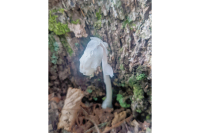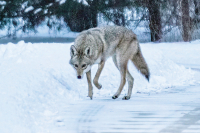Final decision reached on Buck Project
 This stand on Chunky Gal Mountain is scheduled for harvest under the Buck Project decision, but groups represented by the Southern Environmental Law Center that like to see it added to the Southern Nantahala Wilderness fear logging would imperil that goal. MountainTrue photo
This stand on Chunky Gal Mountain is scheduled for harvest under the Buck Project decision, but groups represented by the Southern Environmental Law Center that like to see it added to the Southern Nantahala Wilderness fear logging would imperil that goal. MountainTrue photo
The U.S. Forest Service has signed the final decision notice for the Buck Project, which will encompass more than 32 square miles on the Nantahala National Forest’s Tusquitee Ranger District in eastern Clay County.
The project will use commercial timber sales toward the goal of providing young forest habitat and producing more oak and hickory trees over time. It will also use prescribed burning to promote the unique Serpentine Barrens and aim to improve water resource conditions through stream improvement projects.
A draft decision and finding of no significant impact released in August 2019 drew three formal objections, submitted by Ruffed Grouse Society member Jim Gray, the Clay County commissioners and the Southern Environmental Law Center on behalf of MountainTrue, The Wilderness Society, Defenders of Wildlife, Sierra Club and Appalachian Voices.
Gray’s objection stated that the preferred alternative would not include enough timbering to sufficiently improve habitat for species that depend on early successional habitat, particularly ruffed grouse. The bird’s population is not stable, Gray wrote, and is in fact declining in the state. The proposed 845 acres of young forest habitat that the plan would create in the 20,638-acre area is “totally inadequate” to address the grouse’s habitat needs, he said.
The Clay County commissioners wrote that the plan would not include enough clear cutting to create sufficient food for wildlife, opportunity for indigenous plant species or jobs for Clay County residents who rely on the timber industry economically.
“Old growth does not provide food for wildlife,” wrote Chairman Robert Peck on behalf of the board. “Only certain clear cuts as well as select cuts will allow sprouts to grow and provide the necessary food for various habitats. Making roads throughout is vital for preventing forest fire as well as fighting forest fires.”
Related Items
The SELC criticized the draft decision for an opposite set of reasons, in a 56-page objection stating the old growth forest is essential wildlife habitat and that road construction would result in adverse impacts for years to come. The group also said that additional analysis was needed before a viable plan could be created.
“Since the inception of this project, we have expressed deep concerns about the intensity of logging proposed in a unique and ecologically complex part of the Nantahala National Forest,” the objection reads. “Against the backdrop of a decades-old forest plan, rooted in an analysis that has grown stale, we noted the agency had a choice: it could avoid the impacts that were either not considered in the prior forest plan or for which the analysis has become outdated, or it could do the work to consider those impacts, both direct and cumulative, at the project level. The Forest Service takes an untenable path by deciding to log across a sensitive project landscape without analyzing those impacts.”
In November, an objections resolution meeting was held.
“The final decision incorporates changes resulting from the meeting including: identifying logging methods, committing to decommissioning all temporary roads at the completion of the project, and implementing practices to minimize the spread of invasive species,” reads a press release from the Forest Service. “Additional detail on the impacts to wilderness characteristics in the Boteler and Chunky Gal areas is included. Implementation within three units that may be in an area recommended for wilderness in the revised forest plan will wait until the forest plan decision is signed to determine how to proceed.”
Both Gray and Peck said that they support the final decision.
“In general, we fully support the USFS and the Buck Creek Project,” said Peck. “We believe in partnering to make our forests environmentally sustainable, while allowing for a continued source of recreation and aesthetic beauty for future generations. We want to ensure a healthy ecosystem for the entire wildlife habitat.”

The yellow serpentine ragwort is found only in the Serpentine Barrens. The U.S. Forest Service believes that treatments in the Buck Project will benefit its populations. USFS/Gary Kauffman photo
Gray said that he accepts the decision as “the best outcome that could be achieved under the circumstances” but would have liked to see more logging than the 795 acres in the final decision, as additional young forest habitat is needed.
“Wildlife, which benefit from the regrowth of the forest after a timber harvest, has not received enough attention in forest management over the past 20-plus years,” said Gray. “The Buck Project is a step in the right direction.”
However, the SELC decried the decision in a statement titled “Decision to log forest ignores public input and science, threatens trout streams.” On behalf of the five groups it represented, SELC characterized the action as a decision to “charge ahead with irresponsible plans” to log areas that contain headwaters and steep backcountry areas and said that it “invites unnecessary conflict during the ongoing forest plan revision for the Nantahala National Forest.”
“This decision ignores public input and support for an alternative proposal that eliminated the riskiest logging and protected clear-running and popular trout streams and old, biologically rich forests,” said Amelia Burnette, a senior attorney with the Southern Environmental Law Center. “The agency fell short of its obligation to consider harmful impacts of its logging plan and disclose them to the public.”
The statement said that of the 670 comments that the USFS received regarding the project, over 90 percent favored less or no logging, and that the project is likely to do more to harm populations of the imperiled golden-winged warbler than to help it as intended. In particular, the SELC objected to logging in the backcountry of Chunky Gal Mountain due to the roads that would have to be cut through the remote area, which the groups represented by the SELC would like to see designated as wilderness.
“We oppose logging parts of the forests that are eligible for wilderness protection under the agency’s own regulations,” said Hugh Irwin, conservation planner with The Wilderness Society. “By committing these backcountry wilderness areas to a future timber sale before adequately considering public feedback on how these areas would be managed in a new forest plan, the agency seals their fate, and diminishes the role of the American public in shaping the future of these forests.”
Josh Kelly of MountainTrue added in an email that he believed the protracted planning process squandered resources that could have been used more constructively.
“The decision to push the Buck Project into controversial areas slowed the project down by at least 18 months by my reckoning, and that’s 18 months that could have been used to move another project along,” said Kelly. “The strategy the Forest Service chose will not only damage some places that don’t need to be logged, but it is also damaging relationships and wasting money.”
The project was first introduced to the public in 2017 through the National Forests in North Carolina website, by mail, and at a public meeting at the Hinton Rural Life Center. A draft environmental assessment was released for a 30-day notice and comment period on April 10, 2019. A draft decision notice was released on Aug. 14, 2019, initiating a 45-day objection period.
Work in the project area could begin in late 2020 and will continue for five to seven years.
“The ultimate goal of the Buck Project and all our work on the district is a healthy, diverse forest that sustains wildlife. It takes continued commitment from state agencies, conservation and environmental organizations, and the public to get there,” said Tusquitee District Ranger Andy Gaston. “As we finalize the decision on this project, we’re already engaging the public and partners on ideas for future work.”
Nearly 70 percent of the trees in the project area are more than 81 years old. Across the Nantahala and Pisgah National Forests, the trend toward older trees is increasing such that in 50 years nearly half of the forest will be comprised of trees older than 130 years, according to the Forest Service. Only 0.5 percent of the project area is young forest, defined as trees up to 10 years old.
The Buck Project will leave 96 percent of the 20,638-acre area untouched, and it will not use clear cutting. Instead it will use a forestry treatment called “shelterwood with reserves” that leaves some large trees behind. In 30 separate stands over an area of 795 acres, most large trees will be cut to make room for young trees to grow. The average size of each harvest treatment is 26 acres.
Removing patches of older trees gives young trees access to sunlight and water, allowing them to sprout and grow and creating openings for herbaceous plants that can support other species as well.
The Buck Project includes 17 stream improvement treatments to restore stream habitat quality and connectivity and reduce sediment to streams. Additional treatments include thinning and prescribed burning to improve ecological conditions in fire-dependent plant communities like the serpentine barrens.
More information, including the objections received, is available at go.usa.gov/xV3Ew.













